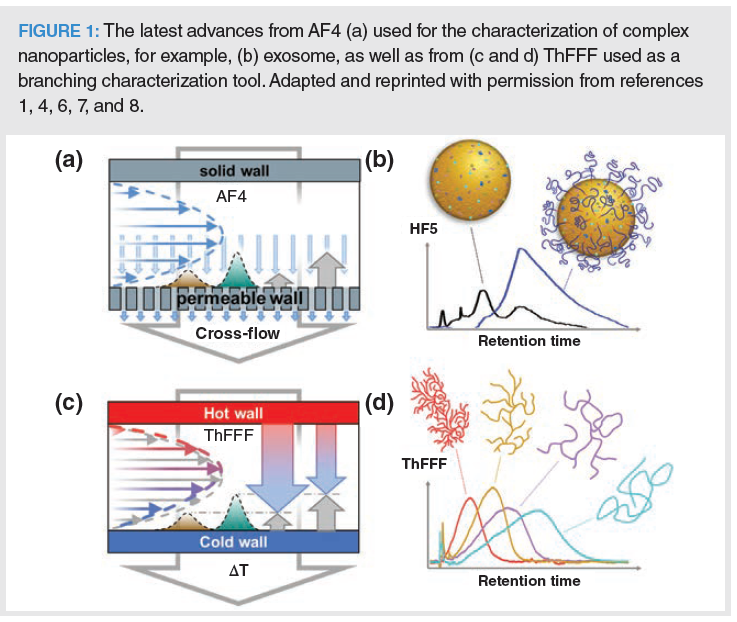Separation Science: The State of the Art: Field-Flow Fractionation: Extended Frontiers to Supramolecular and Complex Polymer Materials
The development of multidetection field-flow fractionation (FFF) has made a global impact on the research and development of advanced separation and analysis of novel, supramolecular, and complex polymers. Owing to their multiple functionalities and applications in advanced nanotechnology, the accurate and reliable characterization of advanced materials is essential for both the material design and development processes. As highlighted in Figure 1, the utility of FFF, namely asymmetrical-flow FFF (AF4), hollow-fibre-flow FFF (HF5), and thermal FFF (ThFFF), has been instrumental in extending the frontiers for the separation and analysis of supramolecular and complex polymers (1). These FFF subtypes have the ability to separate at low‑shear conditions as a function of distinct separation force-fields across a flat ribbon-like channel with a laminar and parabolic solvent flow-profile. Examples of force-fields are a thermal gradient and a cross-flow stream, applicable for ThFFF and AF4/ HF5, respectively.

Essential AF4/HF5 research avenues focus on the deep understanding and elucidation of structural transformations within complex macromolecular samples depending on different parameters, such as molar mass, cross-linking, pH, and concentration. Here, we are using the power of multidetection to provide a large amount of information within a single measurement. We consider a variety of parameters that describe the molecular shape in dilute solutions, such as the scaling or Mark-Houwink exponent, as well as the ratio of the hydrodynamic radius (Rh) to the radius of gyration (Rg) (shape parameter). Additionally, apparent density, which is molar mass-dependent, aids in validating the conformational data. Particularly noteworthy is the AF4-5D (quintuple detection consisting of multi-angle light scattering [MALS], dynamic light scattering [DLS], refractive index [RI], UV, and viscometry) applicable for evaluating the internal folding process of single-chain nanoparticles (2). Here we demonstrate that increased internal cross-linking density results in higher compactness.
Continuously improving AF4 protocols for in-depth vesicle characterization (polymersomes [3] and exosomes [4]) are of the utmost importance to understanding structural transformations dependent on loading or modification processes. Here, it is possible to get quantitative and qualitative information, as well as the locus of the encapsulated drug or protein, which helps in optimizing the loading or modification processes. AF4 elucidates the intra- and intermolecular interactions between various types of fragile nanostructures (the combination of polymers, proteins, nanoparticles, and/or enzymes) and their conformational effects (5).
A single measurement can provide even more information when coupling state-of-the-art quintuple-detection to ThFFF. In addition to molar mass, size, shape, apparent density, and intrinsic viscosity, we can also separate according to microstructure, topology, and composition owing to the thermophoretic properties of the analytes.
Regarding ThFFF’s capability in the characterization of polymers, great advances have been made to transform from an empirical trial‑and‑error procedure to a targeted theory‑based method, including retention predictions (6). Furthermore, ThFFF has evolved its potential to act as a complementary tool for branching or topology characterization, as shown recently for aromatic-aliphatic polyester (7) and chain-walking polyolefins (8). This sets the basis for ThFFF to be a promising branching characterization tool for polyolefins.
ThFFF has also shown its potential in the characterization of polymeric nanoreactors (9). A new trend in the development of ThFFF is the characterization of metal-polymer hybrids for subsequent exploitation of their plasmonics as highly sensitive electromagnetic probes for investigating size, shape, and composition dynamics with higher resolution. When exposed to electromagnetic irradiation, metal nanoparticles exhibit highly sensitive and intensive plasmonic behaviour as a function of shape, size, and composition, and this is analyzable with higher reliability using advanced UV–vis spectroscopy coupled to ThFFF.
References
1) U.L. Muza, S. Boye, and A. Lederer, Anal. Sci. Adv. 2, 95–108 (2021).
2) J. Engelke, S. Boye, B.T. Tuten, et al., ACS Macro Lett. 9(11), 1569–1575 (2020).
3) H. Gumz, S. Boye, B. Lyisan, et al., Adv. Sci. 6, 1801299 (2019).
4) S. Lathwal, S.S. Yerneni, S. Boye, et al., PNAS 118, e2020241118 (2021).
5) B. Kaupbayeva, H. Murata, K. Matyjaszewski, et al., Chem. Sci. 12, 13848–13856 (2021).
6) M. Geisler, L. Plüschke, J. Merna, et al., Anal. Chem. 92(21), 14822–14829 (2020).
7) W.C. Smith, M. Geisler, A. Lederer, et al., Anal. Chem. 91(19), 12344–12351 (2019).
8) M. Geisler, W.C. Smith, L. Plüschke, et al., Macromolecules 52(22), 8662–8671 (2019).
9) U.L. Muza, G. Greyling, and H. Pasch, Anal. Chem. 90(23), 13987–13995 (2018).
Susanne Boye is senior scientist at the Polymer Separation Group and leader of Field-Flow Fractionation and Thermoanalysis, Center Macromolecular Structure Analysis, Leibniz- Institut für Polymerforschung Dresden e.V., Germany.
Upenyu Muza is a Marie Sklodowska-Curie Actions_ Individual Fund_Fellow (postdoctoral) at the Polymer Separation Group, Center Macromolecular Structure Analysis, Leibniz-Institut für Polymerforschung Dresden e.V.
Martin Geisler is a postdoc at ThieleLab Group, Department Nanostructured Materials, Leibniz-Institut für Polymerforschung Dresden e.V.
Albena Lederer is leader of the Polymer Separation Group, head of Center Macromolecular Structure Analysis, Leibniz- Institut für Polymerforschung Dresden e.V., and SASOL chair in Analytical Polymer Science at Stellenbosch University, South Africa.

Retaining Talent in Field-Flow Fractionation: An Initiative
The authors present their motivation for establishing the Young Scientists of FFF (YSFFF) initiative within the FFF community.
Developments in Field‑Flow Fractionation Coupled to Light Scattering
December 8th 2020Field-flow fractionation (FFF) coupled to light scattering is a powerful method to separate and characterize nanoparticles, proteins, and polymers from a few nanometres to a few micrometres. The technique is one of the few that can cover the full size range of nanomaterials and provide high-resolution size distributions and additional characterization. New developments in FFF enhance performance and productivity.
Field-Flow Fractionation: Virtual Optimization for Versatile Separation Methods
August 8th 2017Flow-field flow fractionation (flow-FFF) offers highly versatile separations for the analysis of complex fluids, covering a size range of macromolecules and particles from 1 nm to 10,000 nm. However, flow-FFF is often perceived as a difficult technique to learn because of the multiple parameters available for adjustment. Recent advances in software for simulating flow-FFF overcome this obstacle, enabling the virtual optimization of flow-FFF methods and opening up the power of flow-FFF separations to non-experts. An added benefit is the ability to easily analyze particle size distributions by elution time from first principles.















